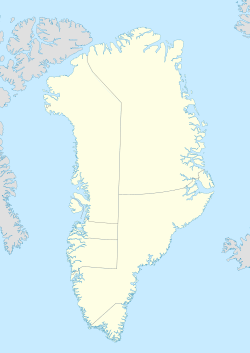Nipisat Island facts for kids
| Geography | |
|---|---|
| Location | Davis Strait |
| Coordinates | 66°48′50″N 53°30′30″W / 66.81389°N 53.50833°W |
| Area | 1.03 km2 (0.40 sq mi) |
| Administration | |
|
Greenland
|
|
| Municipality | Qeqqata |
| Official name: Aasivissuit – Nipisat. Inuit Hunting Ground between Ice and Sea | |
| Type: | Cultural |
| Criteria: | (v) |
| Designated: | 2018 |
| Reference #: | 1557 |
| State Party: | |
| Region: | Northern Europe |
Nipisat Island is a small island located in Greenland. Its name means "Lumpfish" in the Kalaallisut language. This name comes from the island's shape, which looks like a lumpfish. Today, no one lives on Nipisat Island. It is known for its important history and ancient discoveries. In 2018, it became a UNESCO World Heritage Site.
Contents
Geography of Nipisat Island
Nipisat Island is found about 15 kilometers (9 miles) south of Sisimiut. It sits along the coast of the Davis Strait. The island is part of a group of small islands and rocks. These are located near the entrance of the Ikertooq Fjord. Just west of Nipisat is Sarfannguit Island.
Plant Life on Nipisat
The plants on Nipisat Island are mostly small shrubs. You can find Dwarf birch and Arctic willow growing there. There are also many lichens and other small plants. These plants are common in cold, northern areas.
History of Nipisat Island
Nipisat Island has a long and interesting history. People have visited and lived there for thousands of years. In the 1700s, Europeans began to arrive.
Early European Visitors
In 1723, a Danish missionary named Hans Egede visited Nipisat. He saw local people hunting large whales. The Danes then set up a trading post on the island. This was their first settlement there.
Two years later, a small mission was built. But it was soon left empty. Dutch whalers later burned it down. In 1727, Danish officials suggested building a new trading post. They also wanted a whaling station.
The Fortress and Its Abandonment
In 1728, King Frederick I of Denmark ordered a fortress to be built on Nipisat. This was meant to protect the Danish interests. However, just two years later, the king changed his mind. He ordered the fortress to be left and everyone to leave the island.
World Heritage Status
On June 30, 2018, Nipisat Island received a special honor. It was named a UNESCO World Heritage Site. This means it is a very important place for all of humanity. It is recognized for its unique history and archaeological value.
Archaeology on Nipisat Island
Nipisat Island is famous for its amazing archaeological site. This site holds many clues about the ancient Saqqaq culture. The Saqqaq people lived in Greenland thousands of years ago. They are not the direct ancestors of today's Kalaallit people. Instead, they are related to groups like the Chukchi and Koryak peoples.
Discovery of the Site
The archaeological site was found in 1989. Finn Kramer, a curator from the Sisimiut Museum, discovered it. The site is about 50 meters (164 feet) from the current coastline. It is on old beaches that are now higher up. The area is between 9 and 13 meters (30 to 43 feet) above sea level.
What Was Found
This part of the island shows no signs of later cultures. These include the Dorset culture or Thule culture. However, it does show signs of the pre-Dorset period. It also shows signs of the Arctic small tool tradition.
From 1989 to 1994, archaeologists worked at the site. They found over 70,000 bone pieces. They also recovered about 1,000 artifacts. These included 314 tools made of stone. These finds have taught us a lot about the Saqqaq culture. Some of the stone tools were new to archaeologists.
See also
 In Spanish: Isla Nipisat para niños
In Spanish: Isla Nipisat para niños


